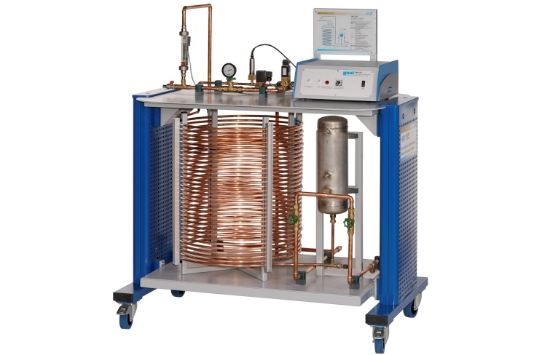Water hammer in pipes is a significant problem in engineering as they can cause severe damage to piping, fittings and system components. Water hammer is caused by the inertia effect of the flowing fluid being subjected to an abrupt changes in velocity, e.g. when rapidly closing a valve. Therefore, knowledge about the emergence of water hammer is an important aspect of designing pipework systems.
The HM 155 trainer can be used to study water hammer and pressure waves in long pipelines. Water hammer is generated by closing a valve at the end of the pipe section. The water hammer is then reflected to the beginning of the pipe as an inverted wave. A pressure vessel with air cushion at the start of the pipe section simulates the open beginning of the pipe, so that there is a clear reflection of the wave. In order to achieve reflection times that are large enough, a 60m long pipe section has been installed, which is shaped as a coiled tube to save space.
In experiments, the emergence of water hammer is studied as a function of the valve closing times. The trainer therefore includes two solenoid valves, one with constant closing time and one with adjustable closing time. The resulting pressure oscillations are measured by a pressure sensor and the pressure curve is displayed by the GUNT software.
A valve is used to adjust the flow rate. System pressure and flow rate are displayed. A safety valve protects the system against overpressure.

Water hammer in pipes
Water hammer in pipes is a significant problem in engineering as they can cause severe damage to piping, fittings and system components. Water hammer is caused by the inertia effect of the flowing fluid being subjected to an abrupt changes in velocity, e.g. when rapidly closing a valve. Therefore, knowledge about the emergence of water hammer is an important aspect of designing pipework systems.
The HM 155 trainer can be used to study water hammer and pressure waves in long pipelines. Water hammer is generated by closing a valve at the end of the pipe section. The water hammer is then reflected to the beginning of the pipe as an inverted wave. A pressure vessel with air cushion at the start of the pipe section simulates the open beginning of the pipe, so that there is a clear reflection of the wave. In order to achieve reflection times that are large enough, a 60m long pipe section has been installed, which is shaped as a coiled tube to save space.
In experiments, the emergence of water hammer is studied as a function of the valve closing times. The trainer therefore includes two solenoid valves, one with constant closing time and one with adjustable closing time. The resulting pressure oscillations are measured by a pressure sensor and the pressure curve is displayed by the GUNT software.
A valve is used to adjust the flow rate. System pressure and flow rate are displayed. A safety valve protects the system against overpressure.
